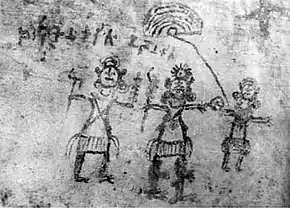Ekanamsha
Ekanamsha (Sanskrit: एकानंशा, Ekānaṁśā) is a Hindu goddesss, identified with Yoganidra a.k.a. Arya. In Sanskrit, Ekanamsha means "the single, portionless one" and it is a name of the new moon.[3] The Indian Theogony: According to S. C. Mukherji, a modern scholar, in the Harivamsa, Ekanamsha is identified as a shakti of Vishnu, she descended as the daughter of Nanda to protect the baby Krishna from Kamsa.[4] In Harivamsa, she is represented as sister of Indra due to which she is also known as Kaushiki. Visnudharmottara purana describes her as Gandhari (power of illusion pertaining to Vishnu) and this Gandhari represents Lakshmi, Dhrti, Kirti, Pusti, Sraddha, Sarasvati, Gayatri and Kalaratri. She is also considered as Subhadhra the sister of Krishna as worshipped in Jagannath temple Orissa. According to the Harivamsa (II.4.37-41), she was worshipped by the Vrishnis.[5] Many "kinship triads", depicting Vasudeva Krishna, Balarama and their sister Ekanamsha have been found in the Mathura region, which are stylistically dated to the early centuries of the Common era.[6]

References
- Paul, Pran Gopal; Paul, Debjani (1989). "Brahmanical Imagery in the Kuṣāṇa Art of Mathurā: Tradition and Innovations". East and West. 39 (1/4): 116–117. ISSN 0012-8376. JSTOR 29756891.
- Gupta, Vinay K. "Vrishnis in Ancient Literature and Art". Indology's Pulse Arts in Context, Doris Meth Srinivasan Festschrift Volume, Eds. Corinna Wessels Mevissen and Gerd Mevissen with Assistance of Vinay Kumar Gupta: 70–72.
- Hawley, John Stratton and Donna Marie Wolf (1986) (ed.) The Divine Consort: Rādhā and the Goddesses of India, Boston: Beacon Press, ISBN 0-8070-1303-X, p.372
- Hudson, Dennis (1986) Piņņai, Krishna's Cowherd Wife in John Stratton Hawley and Donna Marie Wolf ed. The Divine Consort: Rādhā and the Goddesses of India, Boston: Beacon Press, ISBN 0-8070-1303-X, p.256
- Bhattacharji, Sukumari (2000).The Indian Theogony: Brahmā, Viṣṇu and Śiva, New Delhi: Penguin, ISBN 0-14-029570-4, p.173
- Singh, Upinder (2008). A History of Ancient and Early Medieval India: From the Stone Age to the 12th Century. Delhi: Pearson Education. pp. 436–7. ISBN 978-81-317-1677-9.
